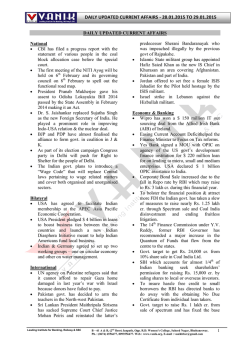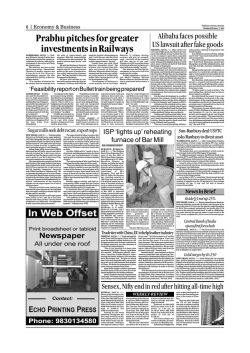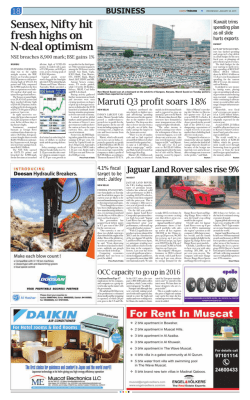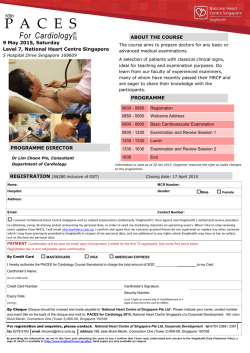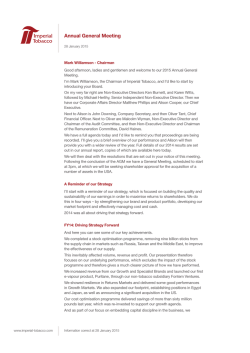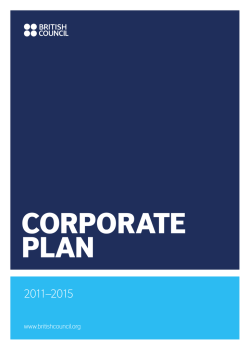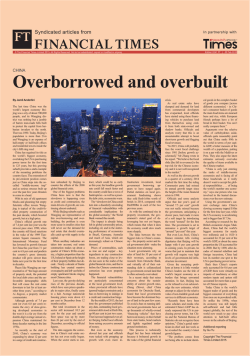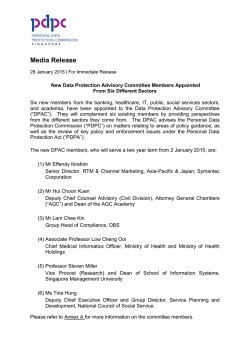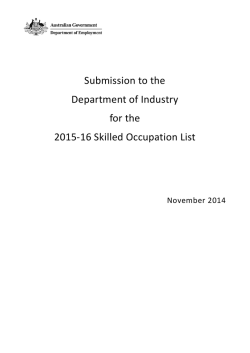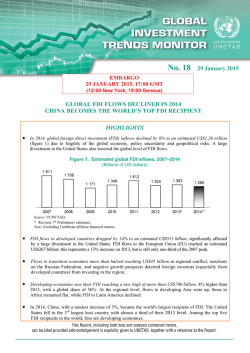
this issue - High Commission of India in Singapore
IS S UE FORTNIGHTLY 159 BIZ E– NEWSLETTER 3 1 J a n u a ry 2 0 1 5 India Focus this issue Indian Economy to be $ 4-5 trillion eco..P.2 Republic Day Celebrations at The High Commission Forex Reserves at record high P.5 Make in India P.7 GIC of Singapore to invest in Bandhan P.11 Investment related developments Nov-Dec P.12-15 India tests Nuclear capable Missile P.19 TOP NEWS » ECONOMY New estimate pushes 2013-14 GDP growth to 6.9% TNN | Jan 31, 2015, 01.28AM IST The 66th anniversary of India's Republic Day was celebrated at the High Commission premises on 26th January 2015. The High Commissioner, Mrs. Vijay Thakur Singh unfurled the National Tricolor in the presence of Indian nationals, persons of Indian origin and friends of India followed by national anthem. The High Commissioner read excerpts from Presidents message to the nation given on the eve of Republic Day. It was followed by cultural programmes by children from Indian schools in Singapore. The government on Friday revised upwards the GDP growth for 2013-14 to 6.9% from the previously reported 4.7% due to a change in the base year and a new method of measuring the size of the economy. The latest data released by the Central Statistics Office (CSO) showed the economy grew 5.1% in 2012-13, also up fr om the pr evious ly r ep or ted 4.5 %. The CSO said the new base year would be 2011-12 replacing the earlier 2004-05 series. The base year is altered every five years and the change in measure of GDP data is to bring it in line with global standards. In the previous series, growth had slipped below the 5% mark for two consecutive years, a factor that contributed to UPA's rout in the 2014 elections. "Changes are also made in the presentation of estimates to improve ease of understanding for analysis and facilitate international comparability," the CSO said. CSO said the new series would ensure comprehensive coverage of the corporate sector by incorporating the annual accounts of companies filed with the corporate affairs ministry. It would also improve coverage of activities of local bodies in rural and urban areas. Further, incorporation of the results of surveys by the National Sample Survey Organisation (NSSO) would help in improving coverage of the unincorporated manufacturing and services sectors. "Incorporation of new datasets have resulted in a correction in the level of GDP, which is likely to affect a wide range of indicators where it is used as a reference point: for instance, trends in public expenditure, taxes and public sector debt that are conventionally analysed in terms of their ratios to nominal GDP. It may be noted that the level of revision in the present base revision is not large enough to affect any of these ratios significantly," it said. The CSO said that henceforth in line with global practices industry-wise estimates will be presented as gross value added (GVA) at basic prices while GDP at market prices will be referred to simply as GDP. The new measure also affects the shares of various sectors of the economy. The share of manufacturing rises while services get a smaller slice of the economic pie. Cont on P. 2 HIGH COMMISSION OF INDIA, SINGAPORE 1 INDIA FOCUS Cont from P. 1.."It reflects a reclassification of the centre," he said. Emphasising that Prime Minister value addition of different segments of an enterprise. This makes it globally more comparable," said Pronob Sen, Chairman of the National Statistical Commission. Explaining the change, he said in the earlier method an integrated firm which was in manufacturing and services would have the two activities put into these sectors. Under the revised method the entire value addition for such a firm would count either under manufacturing or services depending on which of them is the primary activity. Asked whether the changes will push GDP growth in the current year Sen said: Not necessarily." While Chief Statistician T C Anant did not expect a large impact of the data changes on the current year's fiscal deficit target of 4.1% of GDP. Former Planning Commission member Saumitra Chaudhuri said the new data reflected a better picture of the economy. "Previously the services sector was overestimated while the manufacturing sector was underestimated. The new data corrects that anomaly," Chaudhuri said. Indian economy to be $4-5 trillion economy in 10-12 years: MoS finance PTI, 30 Jan,2015 NEW DELHI: Stating it's a great time to invest in India, minister of state for finance Jayant Sinha on Friday said the Indian economy has potential to become a USD 4-5 trillion economy in the next 10-12 years. "You might not find a better opportunity to create wealth. It's great time to invest in India...We are going to take India's USD 2 trillion economy to USD 4-5 trillion economy in the next 10-12 years," Sinha said at an event organized by the Indian Private and Venture Capital Association (IVCA) here. Sinha, who was managing director of Omidyar Network India Advisors, said the rupee has strong tailwinds with firm capital inflows and its great time for investing in the country. He also assured foreign investors that tax issues will be addressed appropriately in the next budget and India was committed to welcoming foreign investment. The minister further said the government wants to develop Mumbai as a major international finance centre. "Why can't India become a international financial centre like Singapore and London? We want to make Mumbai an international financial HIGH COMMISSION OF INDIA, SINGAPORE 2 Narendra Modi's government's core economic philosophy is empowerment not entitlement, Sinha 99.74 per cent of Indian households have bank accounts now. Economy set to take off for 8-9% growth: Arun Jaitley PTI | Jan 22, 2015, 09.13PM IST The economy is set to clock a 6.5 per cent growth next year and then take off to reach 8-9 per cent in the years to come on the back of huge public support for reforms initiated by the government, finance minister Arun Jaitley said on Thursday. "There is a huge amount of popular support, particularly in the backdrop of slowdown in the last two years, that we must grow. "There is fair amount of clarity about the roadmap which is required for that growth. Therefore, I don't think there is any resistance as far as bureaucracy is concerned to the reform process, but the bureaucracy has long been made whipping boy for it," he said while speaking at a BRICS session at the World Economic Forum annual meet. Jaitley further said the manner in which the new government is working, the country will reach 6.5 per cent growth rate next year and "I think that is where the take off will start". Observing that there is also a change of mindset with the change of the government, Jaitley said, "Even if this year (2014-15) we end with about 5.5 per cent growth rate, which is okay by global standards, but India is not smiling at this growth rate". The minister said that 5.5 per cent growth is much below the real capacity of India and the target is get back to 8-9 per cent growth rate "which is more natural to India and I think we have the potential to do that". India's economic growth fell to below five per cent during 2012-13 and 2013-4. During the current financial year, the country's economy is expected to recover and clock a growth rate of 5.5 per cent.The world is showing interest in India which had earlier fell off the global radar, he said, adding the government and policymakers were working to consolidate on these gains and sentiments. Jaitley is scheduled to present the Budget for 2015-16 on February 28 in the Lok Sabha. In the Budget, he will spell out the strategy of the government to boost manufacturing and also economic growth. INDIA FOCUS India world's second most trusted nation, says survey PTI | Jan 20, 2015, 05.52 PM IST Moving up the ranks, India has emerged as the second most -trusted country in the world in terms of faith reposed in its institutions even as globally trust levels have fallen, says a survey. As the world's rich and powerful gather in the Swiss resort of Davos, a study by public relations firm Edelman has found that general level of trust in institutions among college-educated people around the globe are at levels not seen since 2009 in many of the markets it surveyed. Trust in institutions in India has improved sharply in 2015 with the country moving up three notches to the second place among 27 nations. While the number of "truster" countries is at an all-time low of six in 2015, including the UAE, India, China and Netherlands, the number of "distruster" countries has grown significantly to 13, including Japan, Russia, Hong Kong, South Africa and Italy. Brazil, Malaysia, France and the US are among the 8 "neutral" nations as per the trust index, the survey said. India, which last year saw BJP-led NDA government storming to power at the Centre, stands tall. According to the report, an "alarming evaporation of trust" has happened across all institutions, reaching the lows of the Great Recession in 2009. Trust in government, business, media and NGOs in the general population is below 50% in twothirds of countries, including the US, UK and Germany, it said. From fifth most trusted in 2014, India has now become the second-most trusted in 2015 with a score of 79% in the barometer. The study has put Indian Prime Minister Narendra Modi's image on the first page. The list is topped by UAE with 84% trust. Indonesia (78%), China (75%), Singapore (65%) and Netherlands (64%) are the others that have recorded highest levels of trust. Globally, the overall trust index was down a percentage point from the previous year at 55%. Trust levels in major developed economies, such as the US, Germany and France, hovered around 50%. Interestingly, trust in politicians in India has grown to 82% in 2015 from 53% a year ago. Government was the only institution to gain trust in 2015, driven by improvements in 16 countries, including India. After ‘Make In India’, PM to launch opportunities exist in other sectors such as tourism, wellness, yoga, healthcare, education, logisservices initiative The Hindu, January 28, 2015 After the ‘Make In India’ aimed at the manufacturing industry, Prime Minister Narendra Modi is all set to launch a big push to the services sector in April. Mr. Modi will inaugurate a global exhibition on services on April 23 to showcase India’s strength in the sector and provide platform to the industry to explore business opportunities, Commerce and Industry Minister Nirmala Seetharaman said in New Delhi on Tuesday. “Services must grow alongside manufacturing as the services sector contributes over 50 per cent in the country's economic growth.” Over 40 countries are expected to participate in the three-day exhibition, the Minister told reporters. Besides IT, big HIGH COMMISSION OF INDIA, SINGAPORE 3 tics, media and entertainment, R&D, space and hospitality, she said. India’s rank in the global exports of services improved from 11th in 2009 to 6th in 2013 still the scope is tremendous as India’s share in the global services trade is only 3 per cent as compared to 4.6 per cent of China, Commerce Secretary Rajeev Kher said. Services sector has an important role to play in the success of the ‘Make in India’, he said. “Unless we are competitive in services, we will not be competitive in merchandise.” India ran a net surplus of $73 billion in services trade during 2013-14 as exports exceeded imports. The trade surplus in services helped provide for some part of the trade deficit in merchandise of $138 billion. INDIA FOCUS Govt readying reforms in services sectors Live Mint 29 January, 2015 New Delhi: In order to improve its competitiveness in various services sectors, the government is planning to introduce major reforms, both through executive and legislative means, and has formed a committee of secretaries (CoS) to finalize the details. To begin with, the CoS is working on reforms in the area of legal, education and healthcare services. India, despite signing a raft of services trade agreements with countries such as South Korea, Japan, Malaysia and Sri Lanka, has not benefited due to a lack of domestic standards and synergy among different government agencies. “A few years ago, there was an inter-ministerial committee for identifying and working on reforms that are required in various services areas in terms of legislation, practice procedures, etc. That process has reached a point now where we are rolling out consultation at the inter-ministerial level in the form of a committee of secretaries after which we will take it to the logical conclusion through cabinet decisions,” commerce secretary Rajeev Kher said on Tuesday. While services contribute 57% of gross domestic product of a nearly $2 trillion economy, India’s net services exports amounted to a meagre $73 billion in 2013-14 in which software alone accounted for $69 billion. India has a share of 3.4% of the global services trade while China has a share of 4.6%. Keeping in mind the huge potential in services exports, the commerce ministry is organizing a global exhibition of services from 23-25 April to showcase India’s services offerings. More than 40 countries are expected to participate in the fair which will be inaugurated by Prime Minister Narendra Modi. From next year onwards, a services conclave will be held alongside the services exhibition in February. “Global Exhibition on Services (GES) shall create a global platform for increased trade in services. GES will enhance strategic cooperation and develop synergies to strengthen multilateral relationships between all stakeholders, tap the potential for services’ exports and to increase FDI (foreign direct investment) flow in the services sector,” a statement by the commerce ministry said. The focus sectors of the GES are information technology (IT) and telecom, tourism, media and entertainment, healthcare, logistics, profes- HIGH COMMISSION OF INDIA, SINGAPORE 4 sional services, education, research and development, space, and small and medium enterprises. Kher said the CoS is currently working on the improvements that are required on India’s global competitiveness in about 10-12 service areas. “For now we are working on legal, education and healthcare services,” he added. Commerce and industry minister Nirmala Sitharaman said India has a huge potential in many services sectors other than software. These include tourism, the wellness industry, yoga and hospitality. “Unless service sector goes hand in hand with the manufacturing sector, benefits from both sectors cannot be maximized,” she added. PMO hawk-eye on progress of mega projects TNN | Jan 27, 2015, 04.38 AM IST The PMO will monitor big projects involving large investments, Narendra Modi assured investors on Monday. He assured them an open environment that would encourage investment and reward enterprise. Modi gave this commitment as he accepted the proposal of an India-US Forum representative to personally track progress of these mega projects. The project monitoring group, set up by the UPA is under the cabinet secretariat and has helped clear several stalled projects. However, investors would prefer the PMO monitoring the larger projects to accelerate decision making. Getting stalled projects off the ground is important to reviving the manufacturing sector and boosting overall growth. After listening to suggestions made by business leaders, the PM said the solutions to most issues mentioned would be found through three things: Proactive, pro-people good governance, a policydriven state and consistency in policy. Conceding that intellectual property rights are an important issue, he said all countries should together find a solution to it. Modi highlighted key priorities of his government, including improving "ease of doing business", and the "Make in India" initiative. He mentioned the importance of investment in infrastructure, especially in the railways. He said, in agriculture, his "per drop more crop" vision would help tackle farmers' problems, and cope with climate issues and water shortages. The PM said it is important to listen to investors, , as this helps speed up decisions. Modi mentioned his mantra of skill, scale and speed, and said he keeps states on board while taking key decisions. INDIA FOCUS "It will make it easy to do business; our immediate target is to bring us from the rear ranks of the world into the top fifty," Modi told the India-US business summit. "You'll find a tax regime that's predictable and competitive. We've removed some excesses of the past. We'll now address the r ema i n i n g u n c er t a i nt i es , " h e s a i d. Modi listed opportunities for businesses in the government's plans to upgrade infrastructure. He included opportunities in railways, the Clean Ganga mission, urban waste management, connecting villages and homes for every Indian in seven years as areas where opportunities exist. The PM called for strong partnership with the US saying the two countries joining hands would make the world a better place. "India will be an important anchor of stability for the global economy; and an engine for its growth. Above all, a prosperous India will be a force of peace and stability in the world," he said. been deposited in 28% of the accounts, the government is hopeful of scaling up that number in the coming months as the benefits, such as cooking gas subsidy, are transferred directly. Financial services secretary Hasmukh Adhia said once fully rolled out, MNREGS alone will result in the transfer of Rs 33,000 crore a year through bank accounts, while another Rs 25,000-30,000 crore is expected to flow by way of subsidies related to cooking gas. Up to January 14, Rs 6,689 crore have already been disbursed to over 8 crore cooking gas customers, Adhia said in a presentation. While connecting every household with the banking system was the main thrust of the Jan Dhan Yojana, the move will help thousands of crores flow into the formal banking channels, which was so far lying in households with little productive use. Adhia said even Guinness Book of World Records has recognized the achievements made under PMJDY. Jan Dhan covers 99.7% households In its citation, the Guinness Book said: "Most bank accounts opened in one week as part of the TNN | Jan 21, 2015, 02.27AM IST Financial Inclusion Campaign is 18,096,130 and was achieved by the Department of Financial SerBanks, pri- vices, Government of India from August 23 to 29, marily the 2014." public sector players, have Forex reserves at record high of opened 11.5 $322 billion crore accounts under TNN | Jan 24, 2015, 06.55AM IST India's forthe Pradhan eign exMantri Jan change reDhan Yojana s e r v e s (PMJDY), covering 99.74% households and pavtouched a ing the way for transfer of over Rs 65,000 crore record $322 of subsidies and other transfers directly into these billion, suraccounts, the government on Tuesday said. passing the "Most of India today is included in the banking previous system... Except inaccessible households, bank high of alemployees visited every household, and their most $321 strike rate is 99.74%," finance minister Arun Jaitley said, adding that in the long run the initia- billion in September 2011 on the back of Reserve tive will help people to turn to plastic money and Bank of India's conscious efforts to build a war reduce the use of cash in the economy. Among chest. the 21.05 crore households surveyed, 20.99 crore Latest data released on Friday showed an accrehave access to bank accounts. Of the accounts tion of $2.7 billion during the week ended Januopened under Jan Dhan, 51% were held by ary 16, essentially due to a rise in foreign curwomen, while over 59% were in rural areas. Bar- rency assets. Market players said RBI has been ring Jammu & Kashmir, Arunachal Pradesh, buying dollars to ensure that the rupee stays Chattisgarh, Manipur, Meghalaya, Nagaland and strong. The Indian currency closed at 61.44 to a Odisha, all other states have reported 100% cov- dollar on Friday. At current levels, reserves are erage for households, the government said. Al- sufficient to cover imports for eight-and-a-half though, a little over Rs 9,100 crore has so far months. Globally,...Cont on P. 7 HIGH COMMISSION OF INDIA, SINGAPORE 5 INDIA FOCUS World Bank: India to Become Fastest-Growing Big Economy The Wall Street Journal India is on course to overtake China to claim the position as the world’s fastest growing, big economy in the next two years, the World Bank said Tuesday, the latest vote of confidence in the roadmap set out by the new leaders of the South Asian nation to revamp the economy. The Washington-based development institution raised its forecasts for India, saying growth in Asia’s third-largest economy would accelerate in the coming years even as much of the world is slowing down. The reason? New Delhi is implementing changes that will make the country’s economy more efficient and vibrant. Prime Minister Narendra Modi took office in May after his party won a rare majority in Parliament on a campaign promising smaller government and bigger growth. Since taking office, he has unveiled ambitious plans to change how India’s economy is managed. “After several years of stalled progress, the newly-elected government has begun to implement measures to cut red tape, raise infrastructure investment, deregulate key parts of the economy, and shrink the role of government,” the World Bank said in its “Global Economic Prospects“ report released Tuesday. “Implementation stepped up during the fourth quarter, with the opening up of the coal industry to private investors, a deregulation of diesel prices to reduce the fiscal subsidy bill, a relaxation of labor market laws, and a linking of cash transfers with efforts to increase financial inclusion” were all cited by the report as helping in India’s progress towards supercharged growth. While China has held the title as hardest-hitting heavyweight economy for years, it has been suffering through a slowdown and may have to give up the belt in 2017, according to World Bank projections in the report. India has been struggling to emerge from China’s shadow for more than a decade but in 2017 it may at last outgrow its neighbor to the north, expanding 7.0% that calendar year while China’s growth slows to 6.9%. Some other economists–including those at Goldman Sachs—predict India could outpace China as early as next year. The World Bank projects that a few smaller economies—Bhutan, Mozambique and Myanmar for example –will experience larger growth in 2017 but India’s 7.0% expansion will be the fastest among the world’s 50 largest economies. In the calendar year 2017, the globe’s combined gross domestic product expansion will only be 3.2% with high-income countries expanding only 2.2% and developing countries on average growing 5.4%, the World Bank report predicted. Of course the end of 2017 is still a long way away and a lot of things will likely change in the interim to force economists to fix their forecasts. In India, they will be watching closely to see if the country continues to tweak laws and regulations to give companies and consumers more confidence to invest and help the economy expand. “The implementation of reforms and deregulation in India should lift FDI. Investment, which accounts for about 30% of GDP, should strengthen, and help raise growth to 7%,” the World Bank report said. “This is contingent on strong and sustained progress on reforms. Any slackening in the reform momentum could result in a more modest or slower pace of recovery.” HIGH COMMISSION OF INDIA, SINGAPORE 6 INDIA FOCUS MAKE IN INDIA A Major New National Program. Designed To Facilitate Investment. Foster Innovation. Enhance Skill Development. Protect Intellectual Property. And Build Best-In-Class Manufacturing Infrastructure. There's Never Been A Better Time To Make In India. HIGH COMMISSION OF INDIA, SINGAPORE 7 INDIA FOCUS Cont from P. 5..India has the ninth highest forex As some companies may still report, the results reserves with China, Japan and Saudi Arabia leading the chart. But the gap is huge given that China's reserves are in excess of $3.8 trillion -almost 12 times India's level. Unlike the large foreign exchange holders, India has a significant current account deficit, which is mainly due to imports of gold, crude petroleum and electronics. RBI has managed to increase the reserves by over $30 billion or 10% over the past 12 months when China added roughly $23 billion. During this period, Brazil's stock of forex has declined by 0.4% to $374 billion, while Russia's dropped 28% to $339 billion, Bloomberg data showed. Overseas funds bought a record $42 billion of Indian stocks and bonds in 2014 and have invested $3.1 billion so far this year. There are expectations of higher inflows after the European Central Bank announced a $1.2 trillion stimulus on Thursday, especially when the other emerging market economies are on a weaker wicket compared to India. The government and RBI had swung into action after reserves hit a three-year low in September 2013 and the Indian currency hit a record low and breached the 68 level against the dollar due to widening trade deficit. The central bank had put in place checks on outflows and initiated steps to boost inflows. FDI led by equities up 22.6% to Rs. 15 trillion in FY14: RBI India Infoline News Service | Mumbai | January 17, 2015 Of the 13,686 companies that reported inward direct investment, 9,081 companies were subsidiaries of foreign companies. Out of the 17,211 companies that have reported, 15,788 companies had FDI/ODI in their balance sheet in March 2014. Of these, 644 companies had bi-directional direct investment, 13,042 companies received only FDI and 2,092 had only ODI, the RBI said in a press release on Friday. Of the 13,686 companies that reported inward direct investment, 9,081 companies were subsidiaries of foreign companies (i.e., single foreign investor holding is more than 50% of total equity), which also report information on their sales, purchase, exports and imports. Of the 2,736 ODI reporting Indian companies, 1,314 companies had 2,012 overseas subsidiaries. HIGH COMMISSION OF INDIA, SINGAPORE 8 presented below are provisional. Majority of the responding companies were unlisted and most of the companies received only inward FDI. Non-financial companies had a larger share of foreign equity participation (Rs. 2,623.8 billion at face value) as compared with financial companies (Rs. 560.8 billion) in March 2014, the RBI added. Total inward FDI stood at Rs. 15,089.6 billion at market value in March 2014 (Rs. 12,302.5 billion a year ago). A dominant share (93.9 per cent) of FDI was held in equity. Total ODI was placed at Rs. 5,390.3 billion at market value in March 2014 (Rs. 4,279.0 billion a year ago). In ODI too, equity participation took a large share (78.5 per cent). The ratio of outward to inward direct investment at market value increased marginally from 34.8 per cent to 35.7 per cent over this period . Other investment liabilities, which include trade credit, loans, currency and deposits and other payable with unrelated (third party) non-resident entity, stood at Rs. 10,470.0 billion in March 2014 (Rs. 8,319.1 billion a year ago). Corresponding overseas assets accounted for 40.4 per cent of such liabilities. Among the source countries for FDI, Mauritius had the largest share (24.3 per cent) followed by UK (16.0 per cent), USA (15.9 per cent), Singapore (9.6 per cent) and Japan (7.2 per cent). The destination for ODI of Indian companies was largely shared by Singapore (23.5 per cent), Mauritius (14.3 per cent), Netherlands (13.6 per cent) and UAE (10.6 per cent). Both manufacturing and services sectors attracted foreign equity participation. Total FDI stock at market value in the manufacturing and services sectors stood at Rs. 7,458.1 billion in March 2014 (Rs. 6,128.2 billion a year ago) and Rs. 5,987.2 billion (Rs. 4,921.3 billion a year ago), respectively. While manufacturing sector accounted for nearly half of the total FDI at market prices, ‘information and communication services’ (17.1 per cent) and ‘financial and insurance activities’ (12.7 per cent) were the other major activities attracting FDI. Total exports of Indian subsidiaries increased by 16.6 per cent to ` 919.6 billion in 2013-14 whereas their total imports increased by 33.4 per cent to Rs. 1,049.5 billion in 2013-14. Their export-to-sales and import-to-purchase ratios stood at 29.3 per cent and 44.6 per cent, respectively, in 2013-14.Total Sales, INDIA FOCUS including exports, of foreign subsidiaries increased by 11.1 per cent to Rs.15,260.6 billion in 2013-14 whereas their purchase, including imports, increased by 8.5 per cent to Rs. 9,595.6 billion in 2013-14. Their purchase to sales ratio was around 63 per cent. Total exports of foreign subsidiaries companies increased by 14.3 per cent to Rs. 4,900.1 billion in 2013-14. Exports accounted for 32.1 per cent of total sales of subsidiary companies. The ‘Information and communication services’ sector had the highest share of 17.0 per cent in sales, of which, 77.2 per cent was through exports. Total imports of subsidiary companies increased by 7.0 per cent to Rs. 4,395.9 billion in 2013-14. Imports accounted for 45.8 per cent of total purchase of these companies. RBI notifies 100% FDI in construction sector under automatic route The new limit, subject to conditions such as a minimum area developed of 20,000 sq. metre, is effective 2 December 2014 FIRST PUBLISHED: THU, JAN 22 2015. 07 24 PM IST ment of the project or before the completion of project, whichever expires earlier, RBI had said on 8 December. On 3 December 2014, the ministry of commerce and industry had said in a statement that it had approved raising the FDI limit in townships, housing, built-up infrastructure and constructiondevelopment projects, (which would include, but not be restricted to, housing, commercial premises, hotels, resorts, hospitals, educational institutions, recreational facilities, city and regional level infrastructure) in order to catalyse investment in a vital infrastructural sector of the economy. FDI up to 100% but with prior government approval already exists for development of integrated townships including housing, commercial premises, hotels, resorts, the government’s statement had said. BANKING/FINANCE RBI relaxes overseas loan recast rules Jan 24, 2015, 02.44 PM IST | Source: Reuters Mumbai: Reserve Bank of India (RBI) on Thursday notified 100% foreign direct investment (FDI) under automatic route in the construction development sector. The new limit is effective 2 December 2014, RBI said in a notification on its website. In Thursday’s notification, the central bank stated that it had amended the foreign exchange management (FEMA) regulations accordingly on 8 December, to reflect the new limit. The new limit is subject to conditions such as a minimum area developed of 20,000 sq. metre. The company receiving the investment will have to bring in at least $5 million worth of FDI within six months from the commencement of the project. Subsequent tranches of FDI can be brought in over a period of 10 years from the commence- HIGH COMMISSION OF INDIA, SINGAPORE 9 The Reserve Bank of India (RBI) relaxed rules for companies and banks to restructure and reschedule existing overseas borrowings by permitting an increase in the total cost of borrowing offshore. Indian firms have found it difficult to restructure existing borrowings after facing a sharp slowdown in the economy. The banking regulator also allowed changes in the drawdown and repayment schedules of such overseas borrowings, the Reserve Bank of India said in a release on Friday. The easing of rules will however not be applicable for foreign currency convertible bonds, the RBI said. Reserve Bank of India permits banks to act as insurance brokers PTI Jan 15, 2015, 09.31PM IST Seeking to increase insurance penetration in the country, the Reserve Bank today allowed banks to act as brokers for insurers, set up their own subsidiaries and also undertake referral services for multiple companies. The banks have also been allowed to set up subsidiaries and joint venture INDIA FOCUS companies for undertaking insurance business with risk participation, it said. They can also act as corporate agents without seeking prior approval from the RBI. However, they will have to comply with IRDA guidelines. Under existing bancassurance guidelines, a bank can act as a corporate agent and sell policy of only one life insurer and one non-life insurance company. The new guidelines allow banks to act as brokers permitting them to sell insurance policies of different insurance companies. The guidelines follow an announcement made by the former Finance Minister P Chidambaram in 2013-14 Budget. "Banks will be permitted to act as insurance brokers so that the entire network of banks' branches will be utilised to increase the penetration of insurance," the Budget had said. There are about 87 commercial banks in the country with 1.2 lakh branches across the country. There are 52 insurance companies operating in India; of which 24 are in the life insurance business and 28 are in general insurance business. In addition, GIC is the sole national reinsurer. There has been a long pending demand from the insurance industry to allow banks to act as insurance brokers. Regulator IRDA has already issued guidelines in this respect. According to the RBI guidelines, banks are not allowed to undertake insurance business with risk participation departmentally and may do so only through a subsidiary/JV set up for the purpose. Banks which satisfy the eligibility criteria (as on March 31 of the previous year) may approach RBI to set up a subsidiary/joint venture company for undertaking insurance business with risk participation, it said. Elaborating on the condition for setting up subsidiary/joint venture company, it said, the net worth of the bank should not be less than Rs 1,000 crore and the CRAR of the bank should not be less than 10 per cent. The level of net non-performing assets should be not more than 3 per cent, it said, adding the bank have made a net profit for the last three continuous years. The track record of the performance of the subsidiaries, if any, of the concerned bank should be satisfactory, it said. "It may be noted that a subsidiary of a bank and another bank will not normally be allowed to contribute to the equity of the insurance company on risk participation basis," it said. HIGH COMMISSION OF INDIA, SINGAPORE For banks undertaking insurance broking through a subsidiary or JV without risk participation, the the net worth of the bank should not be less than Rs 500 crore after investing in the equity of such company. "RBI approval would also factor in regulatory and supervisory comfort on various aspects of the bank's functioning such as corporate governance, risk management, etc," it said. For setting up JV, a comprehensive board approved policy regarding undertaking insurance distribution, whether under the agency or the broking model should be formulated and services should be offered to customers in accordance with this policy. The policy will also encompass issues of customer appropriateness and suitability as well as grievance redressal. "It may be noted that as IRDA Guidelines do not permit group entities to take up both corporate agency and broking in the same group even through separate entities, banks or their group entities may undertake either insurance broking or corporate agency business," it said. "It must be ensured that no incentive (cash or non -cash) should be paid to the staff engaged in insurance broking services by the insurance company," it added. Violation of the above instructions will be viewed seriously and will invite deterrent penal action against the banks. 'HDFC Bank among world's 50 most valued banks in 2014' PTI | Jan 18, 2015, 12.07PM IST HDFC Bank is the lone Indian entity among the world's 50 most valued lenders in 2014 with a market capitalisation of close to $41 billion. Ranked at the 45th position, the private sector bank is ahead of global majors Credit Suisse, DBS Group, and Standard Chartered with a market capitalisation of $40.58 billion. In the top 50 list compiled by Relbanks, SBI has been ranked at 51th with market capitalisation of $36.40 while ICICI Bank with $33.42 billion is 55th. With more than 70 million customers and over 9,000 locations and a market cap of $284.39 billion, Well Fargo of the USA is the largest bank in the world based on market capitalisation. It is the second largest bank in the US by deposits and debit cards. 10 INDIA FOCUS MARKETS FIIs inflow reaches Rs 21,000 crore so far in Jan PTI Overseas investors have pumped in a staggering over Rs 21,000 crore in Indian capital markets since the beginning of the month owing to easing inflation and rate cut by Reserve Bank of India (RBI). Foreign Institutional Investors (FIIs) have bought shares worth Rs 5,992 crore (USD 977 million) till January 23, while bought debt worth 15,336 crore (USD 2.5 billion) taking the total investment to Rs 21,328 crore (USD 3.45 billion), latest data with Central Depository Services Ltd (CDSL) showed. These investors got re-christened as FPIs or Foreign Portfolio Investors last year under a new regulatory regime that promises to make it easier for them to invest in India. Market analysts attributed the huge inflow to low inflation levels and rate cut by RBI. The central bank on January 14 surprised market participants with a 25 basis point rate cut. Besides, foreign investors are betting on Indian capital markets on expectations of more rate cuts by the apex bank. In 2014, the net investment by overseas investors into the debt markets was Rs 1.16 lakh crore, while in the equities it stood at Rs 98,150 crore. Overall, net investment by foreign investors stood at Rs 2.58 lakh crore in 2014. BUSINESS IFC, GIC of Singapore to invest Rs.1,600 crore in Bandhan The Hindu, January 19, 2015 Microfinance company Bandhan Financial Services is set to get Rs.1,600 crore equity infusion from the International Finance Corporation (IFC) and GIC, Singapore’s sovereign wealth fund. While IFC is an existing equity holder , GIC is picking up fresh equity stake in Bandhan, which also has equity from the Small Industrial Development Bank of India (SIDBI). Within this fiscal, Bandhan expects to pump in Rs.100 crore of own equity, taking its total base to around Rs.3,200 crore, against the existing HIGH COMMISSION OF INDIA, SINGAPORE base of Rs.1,500 crore now, and the Reserve Bank of India’s stipulation of Rs.500-crore capital requirement for a new bank. Bandhan has a 21 per cent capital adequacy ratio. “With the new investment, we are ready to launch a well-capitalised, robust universal bank, which can focus on building assets and managing risks competently,” Bandhan Chairman and Managing Director Chandra Shekhar Ghosh said. The bank will operate about 600 branches across India, with 10 million depositors and a loan book of close to Rs.8,000 crore. The RBI’s in-principle licence was issued in April last, and is valid for 18 months. Bandhan is one of the two entities and the only microfinance non-banking finance company (NBFC) that received the in-principle licence to set up a new bank. Bandhan operates in 22 States through a network of 2,022 branches catering to more than six million customers. It employs 13,800 people. The loan book stands at close to Rs.8,000 crore. Coal India stake sale fetches Rs. 22,600 crore PTI, New Delhi, January 30, 2015 Concluding the largest ever disinvestment, the Centre on Friday raised Rs 22,557.63 crore from the sale of its 10 per cent shareholding in Coal India (CIL). The issue was however, under-subscribed in the retail investors segment; Government-owned insurance companies bought huge proportion of the shares, said sources. Government offered the shares at an auction on the stock exchanges at a floor price of Rs. 358 per share, which was 4.5 per cent less than the closing price on Thursday. The sale was concluded at an indicative price of Rs 358.5 a share that was only slightly higher than the floor price. Of the total proceeds raised, Rs 11,360.11 crore came from insurance companies — both private sector and public sector including the Government-owned Life Insurance Corporation, the official release said. Twitter buys Indian startup ZipDial Source: Indo-Asian News Service Microblogging site Twitter has acquired Indian startup ZipDial, a mobile value added services company based out of Bangalore, a statement by Twitter said here on January 20. Cont on P. 17 11 INDIA FOCUS INVESTMENT RELATED DEVELOPMENTS-NOVEMBER & DECEMBER 2014 RBI Actions: RBI allows Alternative Investments Funds to purchase foreign securities-(http:// www.rbi.org.in/scripts/NotificationUser.aspx?Id=9386&Mode=0) & (http:// www.rbi.org.in/scripts/NotificationUser.aspx) RBI further liberalizes Overseas Direct Investments by Indian Party. The details can be seen from the following link-(http://www.rbi.org.in/scripts/NotificationUser.aspx? Id=9432&Mode=0) RBI issues norms for trading platform for MSME receivables: The Reserve Bank of India (RBI) has permitted setting up of an exchange-based trading platform to facilitate financing of bills raised by Micro, Small and Medium Enterprises (MSMEs) to corporate and other buyers, including government departments and PSUs. The platform, Trade Receivables Discounting System (TReDS) should have a minimum paid up equity capital of USD 4.04 million and non-promoters would not hold over 10% of the equity capital of TReDS. DIPP, FDI Changes: Review of FDI policy in the Construction Development Sector. The details can be seen from the following link-(http://dipp.nic.in/English/acts_rules/Press_Notes/ pn10_2014.pdf) DIPP abolishes licensing for Ammonium Nitrate Fuel Oil-(http://dipp.nic.in/English/ acts_rules/Press_Release/PressRelease_20November2014.pdf) Report on ease of doing business initiative of DIPP, Ministry of Commerce & Industry-(http://dipp.nic.in/English/Investor/Doing_BusinessInitiative.pdf) Some of State Government Initiatives: Telangana unveils industrial policy: The Telangana state government has unveiled its new industrial policy framework encompassing 14 thrust areas. It focusses on developing six industrial corridors and common infrastructure for various industries among other things. The policy framework also listed out sector-specific incentives and steps for a hassle-free and transparent environment for the units to set up and operate. The government expects a growth of 4%-5% over and above the national average in the manufacturing sector on the back of the new policy. It has also promised a conducive taxation structure besides taking steps against tax evasion by undertaking tax rationalization on industrial inputs and outputs with neighbouring states like Karnataka, Maharashtra, Gujarat and Tamil Nadu. Gujarat announces IT policy: Government of Gujarat has announced two more policies in the areas of information technology (IT) and e-governance for 2014-2019. The policy looks to encourage new units, create one million jobs and aim at USD 12.13 billion worth of turnover by 2020. Gujarat will not only look to encourage new IT units, projects as well as parks but also provide incentives for creating quality workforce in the industry. The benefits under the IT policy include 100% waiver in the stamp duty and registration fees over purchase/lease or transfer of land for new units and 25% subsidy for lease/rentals for new units coming up in IT parks, among others. Uttarakhand approves new MSME policy: The Uttarakhand Cabinet has put its seal of approval on the draft of the new micro, small and medium enterprises (MSME) HIGH COMMISSION OF INDIA, SINGAPORE 12 INDIA FOCUS INVESTMENT RELATED DEVELOPMENTS-NOVEMBER & DECEMBER 2014 policy. The decision was taken at a meeting at the secretariat here on Wednesday, government officials said. In the policy, areas for incentives have been divided into categories A and B in the state. Backward districts such as Pithoragarh, Uttarakashi, Chamoli, Champawat, Rudraprayag and Bageshwar have been kept in the category A where the capital subsidy will be 40 per cent. In the category B, districts such as Tehri, Pauri and Almora have been included, and the capital subsidy will be 30 per cent. The interest subsidy in the category A will be 12 per cent while it will be 10 per cent for B. Madhya Pradesh clears investment policy for defence equipment production: MADHYA Pradesh has approved a policy aimed at helping firms willing to USD 81.60 billion or more for setting up public and private sector defence production units in the vicinity of the towns of Katni, Itarsi, and Jabalpur where ordnance factories already exist. Under the policy, a 50-acre undeveloped government land will be provided. Also, land belonging to the closed down and sick units would be purchased for setting up defence equipment manufacturing units. The policy also has a provision for providing subsidy for transporting goods and raw material to and fro the ports. Central Government Initiatives: Railways allows 100% FDI in setting up of bio-toilets, laundry facility: Railways has identified toilets as one of the 17 special areas where 100 per cent foreign and private investment can bring about major investments. According to the guidelines approved by the government under its FDI policy, 100 per cent FDI can be utilised in facilities like cleaning up trains and installation of bio-toilets in passenger coaches and setting up of mechanised laundry facilities. India agrees with US on food stockpiling, clears way for WTO deal: India has reached an agreement with the United States on public stockpiling of food on Thursday, paving the way for the implementation of a global trade facilitation deal that has been stalled for months. "India and the United States have resolved their differences on public stockholding of food," Nirmala Sitharaman said. "This opens the way for implementation of the WTO trade facilitation deal." Australia and India sign agreement to enhance skill development: AUSTRALIA and India will further strengthen bilateral cooperation on skill development. India has also decided to expand the capacities of 12,000 industrial training institutes. A Memorandum of Understanding has been signed between the National Skill Development Corporation, India and TAFE Directors, Australia, on technical and vocational education and training cooperation. The purpose is to further strengthen cooperation to enhance and extend bilateral cooperation. The aim is to contribute positively to the development of technical and vocational education and training related linkages between India and Australia. FinMin revises duty drawback rates: The Finance Ministry has come up with revised all-industry rates (AIR) of duty drawback, effective Saturday. The Central Board of Excise and Customs (CBEC) said under the revised rates, drawback caps will continue on most tariff items, with AIR above 2 per cent. Duty drawback payments are made to exporters to compensate them for the customs and excise duties paid on the inputs used in the manufacture of exportable products. HIGH COMMISSION OF INDIA, SINGAPORE 13 INDIA FOCUS INVESTMENT RELATED DEVELOPMENTS-NOVEMBER & DECEMBER 2014 New duty drawback rates notified for exporters: GOVERNMENT has notified new duty drawback rates to exporters on the duties they pay on imports. While there are no major changes in the new rates, small tweaks have been made in rates pertaining to sectors such as engineering goods, textiles, carpets and certain stationery items. This comes at a time when merchandise exports contracted 5% to USD 26 billion while imports grew 3.6% to USD 39 billion. Government of India sets up USD 2.42 billion fund to boost shipbuilding industry: GOVERNMENT of India (GoI) would support the shipbuilding industry with a dedicated fund of USD 2.4 billion, that will be handled by Exim Bank. The fund will be utilized for financing the construction, and refitting and repair of ships. The shipbuilding sector has a tremendous potential to emerge as a strong foreign currency earner for the country. Recently the government had also announced that it will be acquiring three liquefied natural gas (LNG) carriers locally, as part of a programme to acquire 11 such ships. IREDA & US-Exim Bank Sign MoU : A Memorandum of Understanding (MOU) has been signed between Indian Renewable Energy Development Agency Ltd (IREDA) and US Exim Bank for cooperation on clean energy investment. This MoU will establish a framework for cooperation in the financing of creditworthy entities for renewable energy projects and to facilitate the export of goods and services of U.S. origin or manufactured in India and various forms of collaboration between the IREDA & USExim Bank. US Exim Bank shall provide USD 1 billion medium and long-term guaranteed and/or direct dollar loans to finance U.S. technologies, products and services utilized during commercial development activities within the clean energy sector by IREDA. Railways unveil policy allowing private parcel trains: INDIAN Railways will allow privately owned and run parcel trains. The policy aims at boosting investment in this vital infrastructure sector through public-private partnership (PPP) mode. The ministry of railways issued the new policy to meet the future demand of traffic and thereby increase market share. As per the scheme comprising different categories, Category I would include general service parcel vans of minimum 20 wagons and maximum 24 and Category II would have special purpose vehicles like refrigerated vans, milk tankers etc of 15 or 24 wagons. A rake with mix of both categories will also be allowed to operate. Framework for Security Cooperation between India and Australia: INDIA and Australia have agreed on a framework for security cooperation to reaffirm the bilateral strategic partnership according to which both sides would strengthen defence cooperation and also cooperate on civil nuclear energy and maritime security. Both sides would cooperate in counter-terrorism and other transnational crimes, through cooperation in training and exchange of experts, exchanges on counter-radicalization, cooperation on extradition and mutual legal assistance requests and exchanges on cyber policy. Both would also cooperate on border protection, coast guard, and customs through exchanges and cooperation between the Indian Coast Guard and Australian border protection authorities. India and USA sign infra development agreement: INDIA and the US have signed a Memorandum of Understanding (MoU) for putting in place an infrastructure HIGH COMMISSION OF INDIA, SINGAPORE 14 INDIA FOCUS INVESTMENT RELATED DEVELOPMENTS-NOVEMBER & DECEMBER 2014 collaboration platform that will help the US industry to participate in projects in India. This MoU establishes a United States-India Infrastructure Collaboration Platform, under which both the governments intend to coordinate and cooperate with the goal of facilitating U.S. industry participation in Indian infrastructure projects to improve the bilateral commercial relationship. Indian Railways and Republic of Korea Sign MoU: A Memorandum of Understanding (MoU) has been signed between the Ministry of Railways, Government of India and the Ministry of Land Infrastructure and Transport of the Government of Republic of Korea. The MoU would enable technical assistance and cooperation between the Railways of the two countries on areas such as high speed rail, modernization of rolling stock, railway operations, modernization of signaling, construction & maintenance technologies and in development of logistics parks/terminals. Government initiatives for investment in hydro power development: GOVERNMENT has taken a number of initiatives to boost hydro power development and hydro-power projects in order to meet the country's power requirements. Policy initiatives like National Electricity Policy, Hydro Power Policy, National Rehabilitation & Resettlement Policies and National Tariff Policy have been announced. At present there are 188 hydro stations with a total installed capacity of about 40,800 MW under operation. The total hydro capacity in India at the end of 12th Plan is likely to be around 50,000 MW. Ministry of Textiles approve usage of geotechnical textiles in north east region: MINISTRY of Textiles has approved a scheme for promoting usage of geotechnical textiles in the north east region. The scheme has a financial outlay of USD 67 million for five years from 2014-15. The use of this modern and globally proven technology will help in creating roads and infrastructure in North East, which will require less maintenance and shall have longer life. The scheme will be driven by Textile Ministry's Centers of Excellence and will also provide technological support, capacity building, training, market development support and create awareness about geotextiles by supporting the entire supply chain. India and Russia sign two agreements for Kudankulam project: INDIA and Russia have signed two agreements which for starting units 3 and 4 of the Kudankulam nuclear power project. A strategic vision for strengthening cooperation on uses of atomic energy between the two countries which envisages a roadmap of bilateral cooperation in the civil nuclear energy sector for the next two decades has also been signed. This also includes the construction of additional Russian-designed nuclear power units in India, cooperation in research and development of innovative nuclear power plants and localisation of manufacturing of equipment and fuel assemblies in India. Russia and India will also explore opportunities for sourcing materials, equipment and services from Indian industry for the construction of Russian-designed nuclear power plants in third countries. HIGH COMMISSION OF INDIA, SINGAPORE 15 INDIA FOCUS FORTHCOMING EVENTS >>>> INDIA I. Signature 2015 Date: 20-23 February, 2015 Venue: Bombay Exhibition Centre, Mumbai Organizer: The Gem & Jewellery Export Promotion Council Contact : Mr. Vikrant Pradhan, Asst Director, Email: [email protected] Details: GJEPC is organizing Signature 2015 which will feature 550+ leading Indian companies which will render plenty of sourcing opportunities for all types of gems & jewellery items like loose diamonds and gemstones, gold jewellery, studded jewellery, an exclusive Signature Club for couture collection & International Section to showcase the best of the international manufacturers. II. Assam International Trade & Industrial Fair-2015 Date: 19-25 February, 2015 Venue: Jorhat, Assam, India Organizer: Federation of Industry & Commerce of North Eastern Region (FINER) in association with Department of Industries & Commerce, Government of Assam Contact : www.finer.in Details: The main objective of the fair is to provide a platform for business opportunities and enterprise building with national and international markets. The fair will also provide insight and direction to entrepreneurial aspirations, exposure to new and latest technologies in industry and service sector, showcase new products and technologies, showcase local products to enable trade partnerships and new business opportunities. III. India International Hand woven Fair Date: 11-13 March, 2015 Venue: Chennai, India Organizer: Handloom Export Promotion Council (HEPC) under the aegis of Development Commissioner for Handlooms, Ministry of Textiles, Government of India Contact : www.iihfchennai.com Details: Handloom Export Promotion Council (HEPC) under the aegis of Development Commissioner for Handlooms, Ministry of Textiles, Government of India is organizing the 5th Edition of India International Handwoven Fair (IIHF), from 11th to 13th March, 2015, at Chennai Trade Centre, Chennai, India. In this regard the Council would like to invite prominent buyers of the above mentioned products in Singapore to attend this event. Selected Buyers will be eligible for the following complimentary package: Economy class onward and return airfare. Hotel accommodation for three nights during the fair HIGH COMMISSION OF INDIA, SINGAPORE 16 INDIA FOCUS IV. Gujarat International Handloom & Handicraft Meet “GURJARI 2015” Date: 27 February to 1 March, 2015 Venue: Ahmedabad (Gujarat), India Organizer: Gujarat State Handloom & Handicrafts Development Corporation Ltd and Federation of Indian Chambers of Commerce and Industry (FICCI) Contact : Col V Kodikal, Reg Director, Email: [email protected] Details: GURJARI 2015 is a comprehensive buyer seller meet on Handloom and Handicraft which aims at showcasing Gujarat’s expertise in handlooms and handicrafts. It showcases the best and latest products in handicrafts, handloom, textiles, jewellery, apparels & accessories, carpets , leather paintings, gift ideas, home décor & toys. In this regard the organizers would like to invite prominent buyers of the above mentioned products in Singapore to attend this event. Selected Buyers will be offered the following hospitalities: Economy class onward and return airfare. Hotel accommodation on boarding and breakfast basis at a 5 star hotel in Ahmedabad for three nights during the fair Surface transport at Ahmedabad during the event Twitter buys Indian startup ZipDial.. Cont from P. 10 The statement added this is Twitter's first ever acquisition in India. However, the deal size has not been mentioned.ZipDial has built a mobile platform that lets people follow and engage with content across all interfaces. The user experience combines SMS, voice, mobile web, and access to mobile apps to bridge users from offline to online. ZipDial's platform has engaged nearly 60 million users with hundreds of marketer clients."In India, our primary mission, which is bolstered by this acquisition, is to help every Indian with a mobile device enjoy a great, relevant Twitter experience. We believe Twitter- a platform invented for SMS and rich in media - is a perfect match for India," Rishi Jaitly, market director, India and Southeast Asia, Twitter. This acquisition significantly increases Twitter's investment in India, one of the countries where the company is seeing great growth, and also brings Twitter a new engineering office in Bangalore, the statement added. Christian Oestlien, vice president of product, Twitter, said: "Over the next several years, billions of people will come online for the first time in countries like Brazil, India and Indonesia. For many, their first online experience will be on a mobile device - but the cost of data may prevent them from experiencing the true power of the internet. Twitter, in partnership with ZipDial, can make great content more accessible to everyone." Valerie Wagoner, founder and chief executive officer, ZipDial, said that over half of the world's population live in emerging and newly developed markets, and these consumers use their mobile phones differently. "We build for them. ZipDial's innovative platform has already scaled across South Asia, Southeast Asia and Africa, where we operate. We are thrilled to expand our impact to a global level with Twitter." HIGH COMMISSION OF INDIA, SINGAPORE 17 INDIA FOCUS Notifications Securities and Exchange Board of India Facilitating transaction in Mutual Fund schemes through the Stock Exchange Infrastructure. http://www.sebi.gov.in/cms/sebi_data/attachdocs/1418184464337.pdf Modification to Offer for Sale (OFS) of Shares through stock exchange mechanism http://www.sebi.gov.in/cms/sebi_data/attachdocs/1417587496337.pdf Conditions for issuance of Offshore Derivative Instruments under SEBI (Foreign Portfolio Investor) Regulations, 2014 http://www.sebi.gov.in/cms/sebi_data/attachdocs/1416827082538.pdf Ministry of Corporate Affairs The Companies (Central Government’s) General Rules and Forms Amendment Rules, 2014. http://www.mca.gov.in/Ministry/notification/pdf/CCINotificationGSR815.pdf Reserve Bank of India Overseas Investments by Alternative Investment Funds (AIF) http://www.rbi.org.in/scripts/NotificationUser.aspx?Id=9396&Mode=0 ‘Know Your Customer’ (KYC) Guidelines /Anti-Money Laundering Standards (AML) / Obligation of NBFCs under Prevention of Money Laundering Act (PMLA), 2002 Obligation of NBFCs – Amendment to Prevention of Money-laundering (Maintenance of Records) Rules 2013 http://www.rbi.org.in/scripts/NotificationUser.aspx?Id=9371&Mode=0 Ministry of Finance Auction for Sale (re-issue) of Government Stock Dated 15th December, 2014(295 KB) http://finmin.nic.in/press_room/2014/AuctionSale15122014.pdf Clarification regarding Acquisition & Transfer of Immovable Property in India by Foreign Nationals http://finmin.nic.in/press_room/2014/clarification_Acquist_Transfer_Property_foreignnationals.pdf HIGH COMMISSION OF INDIA, SINGAPORE 18 INDIA FOCUS FAQs on Foreign Investments In India India Tests NuclearCapable Missile 31 Jan, 2015 10:53 a.m. ET The fortnightly FAQs will broadly cover the following areas I. Foreign Direct Investment II. Foreign Technology Collaboration Agreement III. Foreign Portfolio Investment IV. Investment in Government Securities and Corporate debt V. Foreign Venture Capital Investment VI. Investment by QFIs I. Foreign Direct Investment (FDI) The Agni-V is India’s first intercontinental ballistic missile. It has a range of around 5,000 kilometers. The ability to fire it using a mobile launcher increases the number of potential targets India would be able to reach. Saturday’s test from an island in the Bay of Bengal off the eastern state of Orissa was the third of the missile, but the first conducted using a mobile launcher in the form of a missile canister on the back of a military truck. The earlier two launches were done using concrete launch pads. Defence Research & Development Organization—which developed the Agni missile—said in a news release that mobile launching enables firing “of the missile with a very short preparation time as compared to the open launch.”.India is slowly becoming one of the world’s biggest military power s. Its def ens e budget—more than $30 billion last year—is on course to become the fourth-largest in the world . Q. Can Indian companies issue Foreign Currency Convertible Bonds (FCCBs)? Ans. FCCBs can be issued by Indian companies in the overseas market in accordance with the Scheme for Issue of Foreign Currency Convertible Bonds and Ordinary Shares (Through Depository Receipt Mechanism) Scheme, 1993. The FCCB being a debt security, the issue needs to conform to the External Commercial Borrowing guidelines, issued by RBI vide Notification No. FEMA 3/2000-RB dated May 3, 2000, as amended from time to time. Q. Can a foreign investor invest in Preference Shares? What are the regulations applicable in case of such investments? Ans. Yes. Foreign investment through preference shares is treated as foreign direct investment. However, the preference shares should be fully and mandatorily convertible into equity shares within a specified time to be reckoned as part of share capital under FDI. Investment in other forms of preference shares requires to comply with the ECB norms. Source: RBI For Feedback & Comments, please contact: Mr. Pradyumn Tripathi, First Secretary (Commerce), High Commission of India, 31 Grange Road, Singapore- 239702. Email : [email protected] ; [email protected]; [email protected] URL : www.hcisingapore.gov.in HIGH COMMISSION OF INDIA, SINGAPORE 19 INDIA FOCUS
© Copyright 2026
